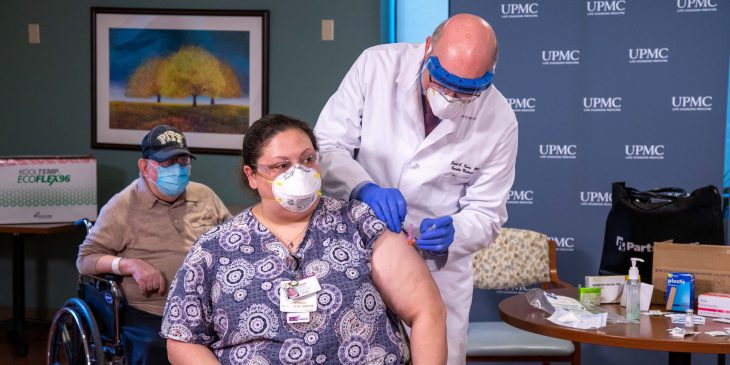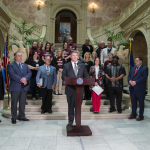At a press briefing today, UPMC leaders discussed the health system’s progress with administering COVID-19 vaccinations to frontline employees.
• 41,700 first doses distributed, or more than half of clinical-facing staff
• 9,000 second doses administered to the earliest vaccine recipients
• Nearly 80% of frontline workers contacted have indicated willingness to get the shot
• More than 1,300 first doses administered to UPMC Senior Community residents and staff
• 75-80% of UPMC Senior Community residents and staff have indicated willingness to get the vaccine
• Approximately 2,300 EMS and non-employed frontline workers vaccinated, with more to come
According to Tami Minnier, UPMC’s chief quality officer, thousands of employees receive vaccinations each day. UPMC’s regional plans are launching this week to share vaccine doses with EMS, police, fire and other critical frontline personnel in the communities we serve.
“UPMC has proven to be a highly efficient distributor of COVID-19 vaccines. As we complete vaccination of our staff and nursing home residents, we look forward to a closer partnership with state and county officials to make sure that, on a region-by-region basis, we can offer vaccination to as many people as possible,” Minnier said.
Public health and government partners are still working through direction and plans for providing vaccinations to the public.
To help long-term care facilities struggling with COVID-19 outbreaks, UPMC joined the Regional Congregate Care Assistance Teams, a state-funded program that leverages the expertise of certain health systems to ensure health care workers and residents in facilities regionally are safe and supported, explained Dr. David Nace, chief medical officer for UPMC Senior Communities.
In addition to sharing vaccines, UPMC has successfully distributed monoclonal antibodies, making them available to COVID-19 patients before they are sick enough to go to the hospital and helping them recover, said Dr. Donald Yealy, UPMC’s senior medical director and chair of emergency medicine.
“For the sickest COVID-19 patients who require intubation and mechanical ventilation, we continue to learn from our clinical experience and add to the knowledge by doing groundbreaking research,” said Yealy. “The data we’ve gathered from the past three months help us counsel these patients and their families as they choose care paths.”
For hospitalized COVID-19 patients over the age of 70 who receive a breathing machine after failing all other support approaches, the death rate is very high at 75%, but overall COVID-19 outcomes are relatively improved compared to the spring, likely because of standardization around evidenced-based care pioneered through the novel UPMC REMAP adaptive platform trials.
“This disease is deadly,” said Yealy. “Right now, the most effective way for you to protect yourself and others is to wear a mask covering the mouth and the nose, to practice physical distancing and avoid congregations outside your family and to wash your hands. This simple set of steps are your vaccine. We know these are the measures that work.”








